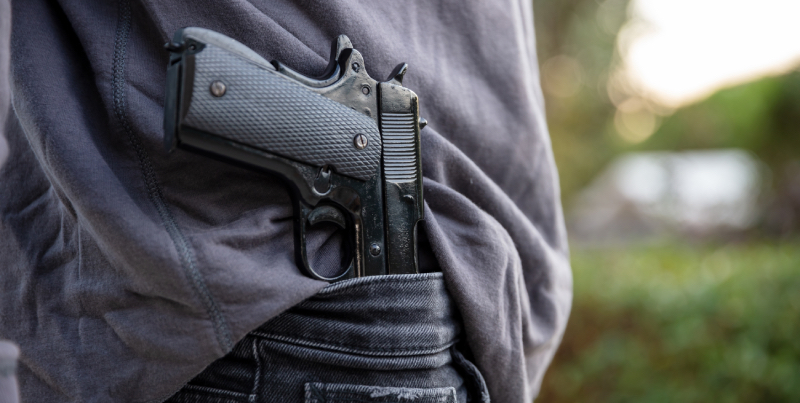Pennsylvania Superior Court Overturns Philadelphia's Open Carry Licensing Requirement
Author: Marko L. | Publish Date: Jul 06, 2025 | Fact checked by: Aleksa Miladinovic
Court Finds City-Specific Gun Law Violates Equal Protection Rights
A significant legal victory for Second Amendment advocates emerged from Pennsylvania's Superior Court on June 23, when judges ruled that Philadelphia's unique open carry licensing requirement violates constitutional protections. The decision centered on the case of Riyadh Sumpter, whose conviction for openly carrying a firearm without a license was vacated by the appellate court.

Background of the Case
The ruling addresses 18 Pa.C.S.A. § 6108, a statute that applies exclusively within Philadelphia city limits. This law requires residents to obtain a license before openly carrying firearms—a requirement that doesn't exist elsewhere in Pennsylvania, where individuals over 18 can legally open carry without special permits.
Sumpter's arrest and subsequent conviction highlighted the disparate treatment of gun rights within the state, setting the stage for a constitutional challenge that would ultimately succeed at the appellate level.
Legal Analysis and Constitutional Violations
Equal Protection Clause Violation
The Pennsylvania Superior Court determined that Philadelphia's open carry ban creates an unconstitutional two-tiered system of rights enforcement. According to the court's analysis, the statute violates the Equal Protection Clause of the 14th Amendment by creating geographic discrimination within the same state.
The court applied strict scrutiny analysis, recognizing that the Second Amendment right to bear arms outside the home constitutes a fundamental right. Under this heightened standard of review, any government restriction must serve a compelling state interest and be narrowly tailored to achieve that objective.
Court's Specific Findings
In its written opinion, the court stated: "Thus, § 6108 places persons within the City of Philadelphia at a special disadvantage in the exercise of their Second Amendment right. The Commonwealth has failed to articulate a compelling interest in support of § 6108. Section 6108 fails to pass strict scrutiny and is therefore unconstitutional under the Equal Protection Clause of the Fourteenth Amendment to the United States Constitution as applied to Appellant."
Historical Precedent Analysis
Bruen Standard Application
The court also examined Pennsylvania's attempt to justify the law through historical precedent, as required by the Supreme Court's decision in Bruen. However, the state's historical arguments were deemed insufficient to support the discriminatory application of firearm regulations.
The ruling noted: "The Commonwealth's attempt to use history to bolster its equal protection argument fails because an examination of history largely misses the focus of an equal protection analysis. Here, when addressing equal protection, we are not so much concerned with the validity of section 6108 as we are with whether Appellant is unfairly discriminated against under that law in comparison to persons outside Philadelphia."
Scope and Implications of the Decision
Limited Direct Application
The court's decision represents an "as-applied" ruling, meaning it directly applies only to Sumpter's specific case. This limited scope means the statute technically remains on the books, though its enforceability has been significantly undermined.
Broader Legal Implications
Despite the narrow application, legal experts suggest the ruling carries substantial persuasive weight for future challenges. According to Gun Owners of America (GOA), the straightforward factual basis for the court's decision provides strong precedent for similar constitutional challenges.
Reactions from Advocacy Groups
Gun Owners of America Response
Dr. Val Finnell, GOA's Pennsylvania director, characterized the decision as a landmark victory for constitutional rights. "This ruling is a historic affirmation of what we've said all along—gun rights don't end at the Philadelphia city line," Finnell stated. "The court rightly recognized that the state's open carry ban in Philadelphia violated the Equal Protection Clause of the 14th Amendment by creating a two-tiered system where the fundamental right to bear arms depends on your zip code."
Continued Advocacy Efforts
Finnell emphasized that the organization views this as part of a broader effort to protect Second Amendment rights statewide. "This is a huge win for the people of Philadelphia, who have been unjustly stripped of their rights under an unconstitutional city-specific law," he concluded. "GOA will continue to stand with Pennsylvanians in all 67 counties to protect and restore the right to keep and bear arms."
Looking Forward
Potential for Further Legal Action
While the immediate impact remains limited to Sumpter's case, the ruling establishes important legal precedent that could influence future litigation. The court's analysis provides a roadmap for challenging similar geographic restrictions on constitutional rights.
Implications for Other Jurisdictions
The decision may also influence how other states and municipalities approach location-specific firearm regulations, particularly those that create disparate treatment of constitutional rights based on geographic boundaries within the same jurisdiction.
The Pennsylvania Superior Court's decision represents a significant development in Second Amendment jurisprudence, emphasizing that constitutional rights cannot be subject to arbitrary geographic limitations within state boundaries.
Author:
Marko Lalovic

Marko is a dedicated aviation enthusiast whose passion began with an unforgettable encounter with fighter jets at an air show in his home country. As an audiophile and sound engineer by training, Marko was initially captivated by the distinctive sonic signature of military aircraft—the thunderous roar of afterburners and the precise mechanical symphony of aviation systems. This auditory fascination evolved into a comprehensive interest in defense technology, particularly firearms engineering and ballistics acoustics.